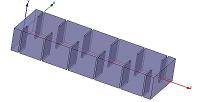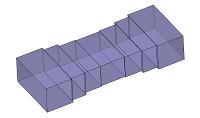WR_Connect
a cool waveguide structure design tool
|
LIST OF EXAMPLES |
|||
|
|
|
|
NEW VERSION |

|
Insertion Loss: 0.07 dB Return Loss: 25 dB Rejection: 90 dB @ 12.75 GHz |
|
Try It |

|
WR-75 Transmit-Reject Filter Insertion Loss: 0.09 dB Return Loss: 25 dB Rejection: 50 dB @ 13.75 - 14.50 GHz |
|
Try It |

|
WR-137 Receive-Reject Filter Insertion Loss: 0.04 dB Return Loss: 25 dB Rejection: 80 dB @ 3.7 - 4.2 GHz |
|
Try It |

|
WR-75 to WR-62 Transition Insertion Loss: 0.01 dB Return Loss: 30 dB |
WR-Connect provides a template for projecting an exponentially matched transformer for different waveguide interfaces. |
Try It |

|
WR-75 High-Pass Filter Insertion Loss: 0.05 dB Return Loss: 30 dB Rejection: 60 dB @ 8.0 GHz |
|
Try It |

|
WR-112 Corrugated Harmonic Filter Insertion Loss: 0.10 dB Return Loss: 25 dB Rejection: 65 dB @ 10.5 GHz (roll-off) 80 dB @ 15.8 - 16.8 GHz (2nd harmonic) 80 dB @ 23.7 - 25.2 GHz (3rd harmonic) 60 dB @ 31.6 - 33.6 GHz (4th harmonic) |
|
Try It |

|
WR-112 Band-Pass Filter Insertion Loss: 0.15 dB Return Loss: 25 dB Rejection: 60 dB @ DC - 7.65 GHz 60 dB @ 9.0 - 18.0 GHz |
The idea of cascading a band-pass iris filter with a corrugated low-pass filter is not new indeed, however using WR-Connect you could design the cascade as a single unit, make it smaller, less loss and free of spurious spikes caused by propagation of high-order modes. |
Try It |

|
WR-75 Spurious Suppression Filter Insertion Loss: 0.02 dB Return Loss: 30 dB Rejection @ 15-17 GHz: 30 dB TE20-mode 30 dB TE01-mode |
This waveguide structure is used to reject spurious spectrum carried by TE20 and TE01 modes. It can be used in combination with a conventional cavity filter and gain far-out-of-band rejection with almost no insertion loss increase. Using WR-Connect you can design a filter like this for 50 seconds in three steps (transformer template, transformer synthesis, connection to its Z-flip). |
Try It |
References:
- Lewis, W. D., "Wave Filter", US Patent # 2,585,563, 1952
- Colling, R. E., "Foundations for Microwave Engineering", McGraw-Hill, New York, 1966.
- Mattai, G. L., L.Young, and E. M. T. Jones: "Microwave Filters, Impedance-matching Networks, and Coupling Structures", McGraw-Hill, New York, 1964.
- Rhodes, J. D., "Stop-Band Filter", US Patent # 3,845,422, 1974
- S.B. Conh "A theoretical and experimental study of a waveguide filter structure", Office Naval Res., Cruft Lab., Harvard Univ., Cambridge, Mass., Rep. 39, Apr. 25, 1948.
- Levy, R., "Tapered Corrugated Waveguide Low-Pass Filter", IEEE Trans. Microwave Theory Tech., MTT-21, August 1973, pp. 526-532.
- Levy, R., "Aperiodic Tapered Corrugated Waveguide Filter", US Patent 3,597,710, Nov. 28, 1969.